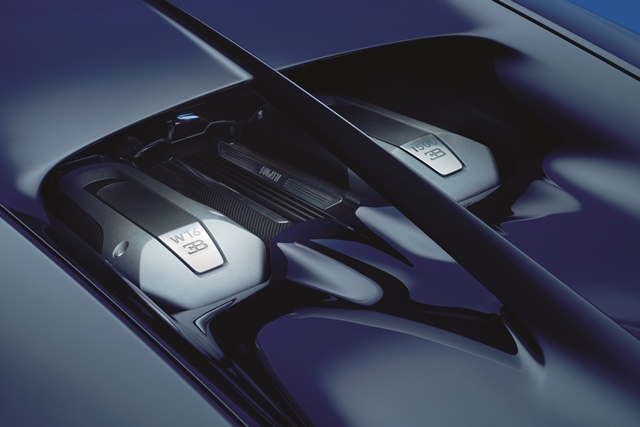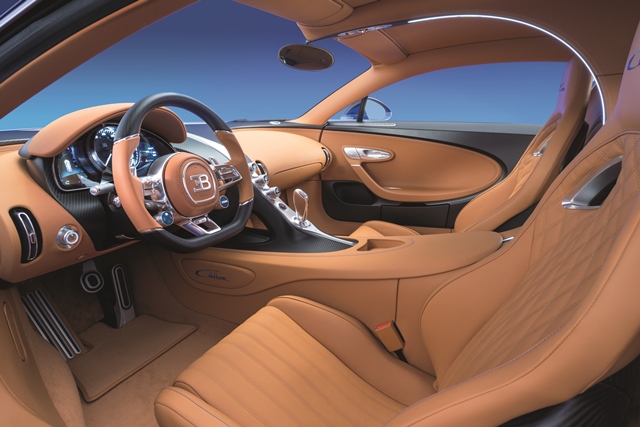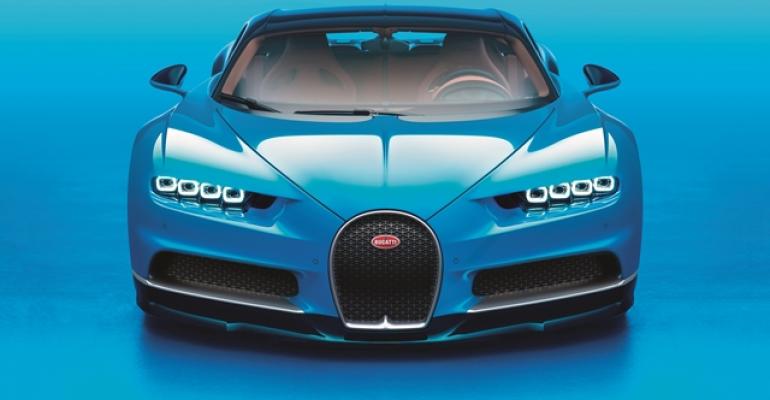GENEVA – The Bugatti Chiron packs a formidable 1,479 hp, accelerates from 0 to 62 mph (100 km/h) in less than 2.5 seconds and reaches a maximum speed of 261 mph (420 km/h), according to official figures released during the unveiling of the successor to the fabled Veyron on the eve of the 2016 Geneva auto show.
Previewed by the Bugatti Vision Gran Turismo concept car at last fall’s Frankfurt show, the immensely powerful Chiron aims to occupy the same position as its highly celebrated predecessor at the very top of the supercar ladder.
That’s a rung above such revered rivals as the McLaren P1, Ferrari LaFerrari and Porsche 918 Spyder, as well as low-volume contenders such as the Koenigsegg Agera, Hennessey Venom and SSC Ultimate Aero.
“The Chiron is the quintessential ultimate super sports car: ultra-modern, incredibly fast, agile and powerful, with a stylistically demanding design and the highest possible levels of comfort,” says Bugatti President Wolfgang Dürheimer. “This combination is not offered by any other market player and gives Bugatti its unique market position.”

Bugatti describes the second of its modern-day marvels as the most powerful road car ever to see series production, although with volumes limited to 500 and a price tag to match its extreme performance at an eye-watering €2.4 million ($2.64 million), it will remain out of reach for all but the seriously wealthy.
Dürheimer, who also heads up Bentley in a dual presidential role under the auspices of parent company Volkswagen, portrays the quad-turbocharged 8.0L W16-powered Chiron as an all-new car that borrows little from the Veyron.
But while the Chiron is comprehensively re-engineered and now boasts full carbon-fiber construction – including the rear section previously fashioned from aluminum, it adopts a similar mechanical package to its record-breaking predecessor, which ceased production at the end of 2014.
In a nod to Bugatti’s illustrious past, the Chiron name is taken from Louis Chiron, a grand prix racer in the 1920s and 1930s who scored notable results in European Championship events, including victory in the 1931 French Grand Prix at the wheel of a Bugatti Type 51. His career was interrupted by war, but he went on to race for a number of notable marques, including Alfa Romeo, Maserati and Mercedes-Benz.
Heritage Styling and Superior Function
Borrowing strong visual cues from the earlier Veyron, the new Chiron boasts an even more dramatic design with tauter surfacing, bolder details and added aerodynamic efficiency. The man credited with the new appearance, Bugatti design boss Achim Anscheidt, says it was developed in close collaboration with Bugatti’s engineering team to ensure greater functionality without any loss in visual impact.
Key exterior design elements include a race-grade front splitter, large horizontal air ducts, a traditional horseshoe shaped grille sporting a Bugatti badge fashioned from silver and enamel, distinctive LED headlamps – each with four individual lenses and integrated air ducts that feed cooling air to the front brakes.

Shapely front wings and a flamboyant semicircular sweep of bodywork extends from the trailing edge of its front wheel arches back towards the rear and into the A-pillars – the latter flourish clearly inspired by the look originally established by Jean Bugatti on the iconic Type 57.
As on the earlier Type 57, there is also a prominent center fin running from the top of the grille across the hood and into the heavily rounded roof, providing an important contribution to the Chiron’s longitudinal stability, according to Bugatti.
An air duct formed by shapely rear pillars replaces the individual air scoops used by the Veyron, channelling air into the engine bay more efficiently and with less turbulence than on its predecessor.
It is at the rear where the more significant differences in appearance between the Veyron and Chiron are apparent, with a strong trailing edge, fully integrated rear spoiler; a full-width LED light band housing the tail lamps, indicators and reverse lamp; sizeable air ducts; large central-mounted exhaust tips; and a race-grade diffuser providing the new Bugatti with a particularly purposeful appearance from behind.
Larger, Heavier, Stiffer
Dimensionally, the Chiron remains close to its predecessor. At 178-ins. (4,521-mm) long, 80.2-ins. (2.037-mm) wide and 47.7-ins. (1,212-mm) tall, the new Bugatti is 3.2-ins. (81-mm) longer, 1.6-ins. (41-mm) wider and 2.1-ins. (53-mm) taller than the Veyron. The wheelbase matches the Veyron at 106.7 ins. (2,710 mm).
The basis for the new Bugatti is a newly developed carbon-fiber monocoque structure. In a departure from that used by the Veyron, it adopts a sandwich construction for the floor and a carbon-fiber-reinforced plastic engine cradle at the rear for added stiffness and lower weight.
The new structure achieves rigidity levels of up to 36,878 lb.-ft. (50,000 Nm) per degree – the sort of stiffness found in the latest LMP1 race cars – but adds weight. The Chiron tips the scales at 4,398 lbs. (1,995 kg), some 342 lbs. (155 kg) more than the original Veyron.

The increase in width has brought greater space to the 2-seat interior and in particular in the front wheel wells of the Chiron, according to Bugatti. Greater height also has liberated an added 0.5 ins. (13 mm) of headroom compared to the Veyron.
The cabin, trimmed in a combination of leather, carbon fiber and brushed aluminum, has been thoroughly redesigned, providing the Chiron with a highly luxurious driving environment. Among the new developments is a passenger airbag that deploys through carbon fiber – a first for a production vehicle.
At the heart of the Chiron is a heavily revised version of the quad-turbocharged 8.0L W-16 gasoline engine used by the Veyron. With a faintly absurd 1,479 hp developed between 1,500 and 6,750 rpm, the mid-mounted unit delivers 492 hp more than the original Veyron launched in 2005. This endows the Chiron with a weight to power ratio of just 3 lbs./hp.
Torque also has risen by a substantial 257 lb.-ft. (348 Nm) over the original Veyron, peaking at 1,179 lb.-ft. (1,599 Nm) between 2,000 and 6,000 rpm.
Significant Mechanical Upgrades Push Performance
Among the more significant developments brought to the Bugatti powerplant is a redesigned carbon-fiber intake manifold, a heavily reworked injection system featuring 32 individual injectors, larger and more powerful turbochargers, a revised intercooler system and a new titanium exhaust system with a total of six catalysts that is claimed to provide a substantial reduction in back pressure over the old system.

In a bid to provide the new Chiron with what Bugatti describes as a more linear delivery of power than the Veyron, the new turbochargers are operated in a 2-stage process. During launch just two turbochargers function, with the remaining two joining in to boost performance when engine speed rises above 3,800 rpm.
The colossal power is channeled through a reworked version of the Veyron’s 7-speed dual-clutch gearbox and multi-plate clutch 4-wheel-drive system – the latter boasting an electronically controlled differential that provides a torque-vectoring function to vary the amount of drive apportioned to each of the rear wheels. It’s the basis for what Bugatti dubs an “easy to drift” function.
While it is yet to undergo final certification testing, Bugatti has released preliminary performance figures suggesting it has achieved its stated aim of making the Chiron faster than the Veyron with claims of 0-62 mph (100 km/h) in less than 2.5 seconds, 0-124 mph (200 km/h) in less than 6.5 seconds and 0-186 mph (299 km/h) in 13.6 seconds. The Veyron boasted times of 2.5 seconds, 7.3 seconds and 16.7 seconds, respectively.
As before, top speed is limited in two stages. The so-called handling mode allows 236 mph (380 km/h) and the top-speed mode provides a maximum of 261 mph (420 km/h), eclipsing the top speed of the original Veyron by 7 mph (11 km/h).
The chassis of the Chiron is a development of that used by the Veyron. To improve ride quality without compromising body control, it adopts an adaptive suspension, providing the new Bugatti with variable ride height and damping control.
In combination with a variable-ratio electro-mechanical steering system, the driver can choose between five different driving modes: Lift, Auto, Autobahn, Handling and Top Speed.
The Lift mode is designed to allow easy transport of the Chiron, increasing ride height for ramps. In Auto, Autobahn and Handling modes the top speed is limited to 236 mph (380 km/h). To engage Top Speed mode, the Chiron requires a Speed Key, which alters the engine management system to provide the claimed maximum velocity.
Bugatti worked closely with Michelin in developing the Chiron to achieve such a top speed. As a result it wears unique 285/30 profile tires on 20-in. rims up front and sizable 355/25 profile tires on 21-in. rims at the rear. The compounds and construction of each are described as being specially developed to handle the enormous forces generated by the engine.

Helping to reining in the vast performance are 16.5-in. (419-mm) diameter front and 15.7-in. (399-mm) diameter rear carbon-ceramic discs grabbed by 8-pot and 6-pot calipers, respectively. Larger than the stoppers used by the Veyron, they provide the Chiron with a claimed 62-0 mph in 103 ft. (31.3 m), 124-0 mph in 410 ft. (125 m) and 186-0 mph in 902 ft. (275 m) – in each case eclipsing the claimed braking distances of its predecessor.
The Chiron will be assembled on the same line used for the Veyron at Bugatti’s headquarters in Mosheim, France, with the first delivery planned for October.
Bugatti appears to have hit the mark with expectant customers, claiming over 160 advance orders already have been received.
“Those who have already considered Bugatti with the purchase of a Veyron will find there is no way they can ignore the Chiron,” says Dürheimer.
Further variants of the Chiron are planned to be launched in the future, including more powerful successor models to the Veyron Grand Sport, Veyron SuperSport and Veyron Grand Vitesse.





